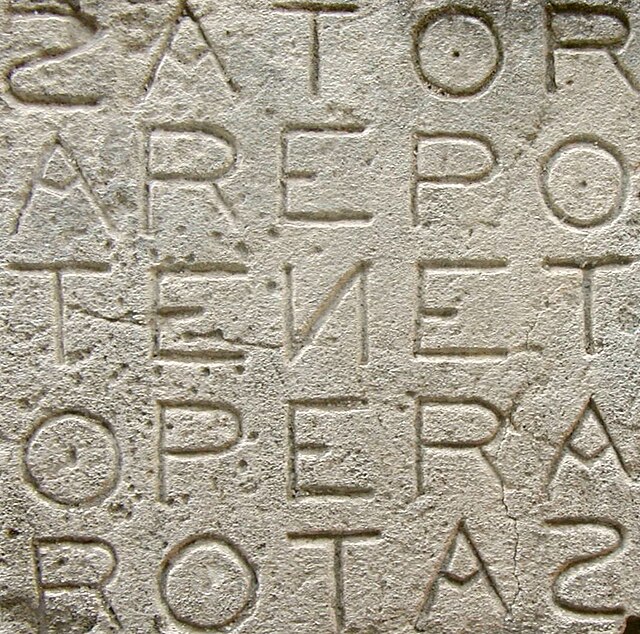The Sator Square is a two-dimensional acrostic class of word square containing a five-word Latin palindrome. The earliest squares were found at Roman-era sites, all in ROTAS-form, with the earliest discovery at Pompeii. The earliest square with Christian-associated imagery dates from the sixth century. By the Middle Ages, Sator squares had been found across Europe, Asia Minor, and North Africa. In 2022, the Encyclopedia Britannica called it "the most familiar lettered square in the Western world".
A Sator Square (laid out in the SATOR-format), etched onto a wall in the medieval fortress town of Oppède-le-Vieux, France
Sator square (in ROTAS-form) on the eight-century facade of Abbey of St. Peter ad Oratorium in Italy
One of the four Sator squares (all in ROTAS-form) found at Dura-Europos, Syria, circa A.D 200.
The oldest known square. Found in 1936 on a column in the Palestra Grande [it] (CIL 8623), it is now kept in the Pompeii Museum.
An acrostic is a poem or other word composition in which the first letter of each new line spells out a word, message or the alphabet. The term comes from the French acrostiche from post-classical Latin acrostichis, from Koine Greek ἀκροστιχίς, from Ancient Greek ἄκρος "highest, topmost" and στίχος "verse". As a form of constrained writing, an acrostic can be used as a mnemonic device to aid memory retrieval. When the last letter of each new line forms a word it is called a telestich; the combination of an acrostic and a telestich in the same composition is called a double acrostic.
Acrostic poem on a tombstone in Kilfane Church, Ireland.
A Sator square (in SATOR-form), on a wall in the medieval fortress town of Oppède-le-Vieux, France
Image: Triple Acrostic by Thomas Browne




![The oldest known square. Found in 1936 on a column in the Palestra Grande [it] (CIL 8623), it is now kept in the Pompeii Museum.](https://upload.wikimedia.org/wikipedia/commons/thumb/3/34/Sator_Square_Palestra_Pompeii_%28CIL_8623_%26_8622a-b%29.jpg/302px-Sator_Square_Palestra_Pompeii_%28CIL_8623_%26_8622a-b%29.jpg)

